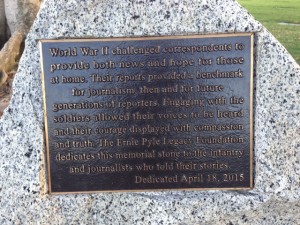The National Society of Newspaper Columnists sets April 18 as National Columnists Day. The 2015 edition is a special one.
The day was chosen because it was on April 18 that Scripps Howard war correspondent Ernie Pyle was killed, shot by a Japanese sniper on a Pacific island, in 1945. That’s 70 years ago to the day.
(NSNC traditionally reposts slightly contrasting holiday histories, “Story behind National Columnists Day” and “National Columnists Day — April 18th.”)
Owen V. Johnson, Ph.D., will be the keynote speaker for the 70th anniversary commemoration of Pyle’s death, 10 a.m. Hawaii time Saturday at National Memorial Cemetery of the Pacific, Punchbowl Crater. (That will be 4 p.m. EDT.)
Johnson is a professor emeritus of journalism from Indiana University, which Pyle, an Indiana native, attended.

Memorial stone for Ernie Pyle, being dedicated on the 70th anniversary of his death, April 18, 2015, at National Memorial Cemetery of the Pacific, Punchbowl Crater, Hawaii.
Photo courtesy Ernie Pyle Legacy Foundation
The Ernie Pyle Legacy Foundation is organizing the ceremony. It will be held about 200 feet away from Pyle’s grave — at the memorial stone that will be dedicated to Pyle’s memory during the program.
“Pyle would have been embarrassed by this commemoration today. He would have said that he was just one of 500 US war correspondents,” goes a paragraph of Johnson’s prepared remarks. “He was the last of 54 of them who died during the war. Most significantly, he would say that the almost 300,000 U.S. troops who died in the war were much more important than he was.”
Pyle, who won a Pulitzer Prize for his columns about U.S. soldiers, was almost 45 when he died, as American forces were wrapping up the Pacific campaign of World War II.
Pyle’s reputation and celebrity as a journalist came because he chose to embed himself with U.S. Army infantry troops fighting in the war’s most hostile battles: from North Africa to Anzio, Italy, and Normandy Beach in France on D-Day. By focusing on the ordinary G.I., he brought the war home through columns that appeared in some 400 daily and 300 weekly newspapers.

